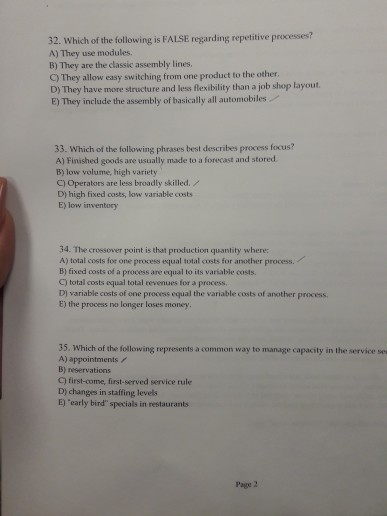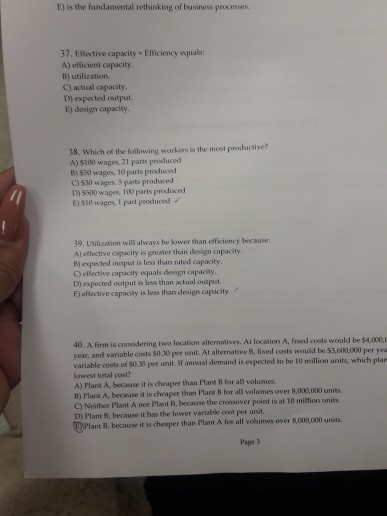Answered step by step
Verified Expert Solution
Question
1 Approved Answer
32. Which of the following is FALSE regarding repetitive processes? A) They use modules. B) They are the classic assembly lines. C) They allow


32. Which of the following is FALSE regarding repetitive processes? A) They use modules. B) They are the classic assembly lines. C) They allow easy switching from one product to the other. D) They have more structure and less flexibility than a job shop layout. E) They include the assembly of basically all automobiles/ 33. Which of the following phrases best describes process focus? A) Finished goods are usually made to a forecast and stored. B) low volume, high variety C) Operators are less broadly skilled. / D) high fixed costs, low variable costs E) low inventory 34. The crossover point is that production quantity where: A) total costs for one process equal total costs for another process. B) fixed costs of a process are equal to its variable costs. C) total costs equal total revenues for a process. D) variable costs of one process equal the variable costs of another process. E) the process no longer loses money. 35. Which of the following represents a common way to manage capacity in the service sew A) appointments / B) reservations C) first-come, first-served service rule D) changes in staffing levels E) "early bird" specials in restaurants Page 2 E) is the fundamental rethinking of business processes. 37. Effective capacity Efficiency equals: A) efficient capacity. B) utilization. C) actual capacity. D) expected output. E) design capacity. 38. Which of the following workers is the most productive? A) $100 wages, 21 parts produced B) 550 wages, 10 parts produced C) $30 wages, 5 parts produced D) $500 wages, 100 parts produced E) $10 wages, I part produced 39, Utilization will always be lower than efficiency because: A) effective capacity is greater than design capacity. B) expected output is less than rated capacity. C) effective capacity equals design capacity. D) expected output is less than actual output. E) effective capacity is less than design capacity: 40. A firm is considering two location alternatives. At location A, fixed costs would be $4,000,0 year, and variable costs $0.30 per unit. At alternative B, fixed costs would be $3,600,000 per yea variable costs of $0.35 per unit. If annual demand is expected to be 10 million units, which plam lowest total cost? A) Plant A, because it is cheaper than Plant B for all volumes. B) Plant A, because it is cheaper than Plant B for all volumes over 8,000,000 units. C) Neither Plant A nor Plant B, because the crossover point is at 10 million units. D) Plant B, because it has the lower variable cost per unit. Plant B, because it is cheaper than Plant A for all volumes over 8,000,000 units. Page 3
Step by Step Solution
★★★★★
3.48 Rating (161 Votes )
There are 3 Steps involved in it
Step: 1
The detailed answer for the above question is provided below Answer 32 False Repetitive processes are typically used to produce high volumes of identical or similar products such as products of the sa...
Get Instant Access to Expert-Tailored Solutions
See step-by-step solutions with expert insights and AI powered tools for academic success
Step: 2

Step: 3

Ace Your Homework with AI
Get the answers you need in no time with our AI-driven, step-by-step assistance
Get Started


